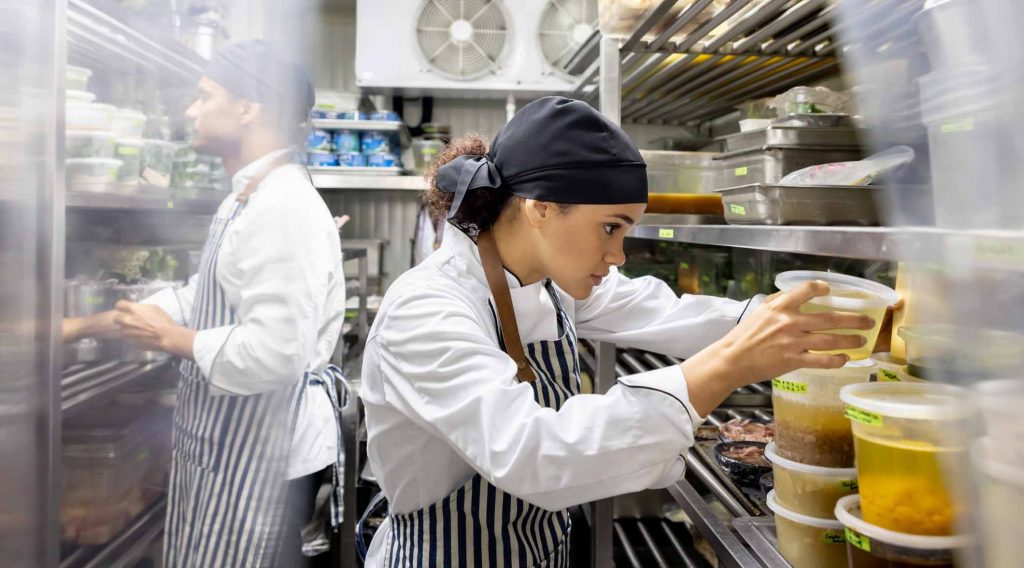
AI has arrived and it’s here to stay
Artificial intelligence (AI) and the many possibilities it offers us were a big discussion point this year. It has been talked about as a futuristic concept for a while but now it finally feels like we’ve begun to understand how to harness it’s potential. I’m certain that AI will have a role in all our futures. For those of us in food and hospitality there are many ways intelligent machines could become part of the industry. AI sommeliers were just one concept I came across at SXSW; they could have access to vast amounts of knowledge from all over the world and a complex understanding of ingredients and flavour pairings. And it doesn’t end there, advances in machine learning combined with AI means that we have begun to see it used to simplify cooking, develop new foods and recipes, reduce food waste and even farm more efficiently.
Bonding with bots
You may have already encountered a form of AI via chatbots, these were another hot topic this year. A chatbot is a computer programme that aims to simulate human conversation or chat and, in some cases, this is achieved through artificial intelligence. They sit within instant messaging applications, such as Facebook Messenger or Kik and are particularly useful for customer service as well as online bookings and ecommerce. There are examples of chatbots in use in hospitality and foodservice already. I have booked tables using them and their use certainly looks set to increase. Whilst at SXSW I came across the prediction that by 2020, 80% of brands will be using chatbots for customer interactions. (source: Oracle).
Why are chatbots proving so popular? It’s thought that people now spend more time in social messaging apps, than they do in social media. In other words, they’re spending longer communicating via Facebook messenger than they are browsing their Facebook feed. You’ve heard the adage “be where your customers are,” chatbots allow brands to do this and have a presence within various popular messenger applications. With people using and downloading fewer apps than before, brands need a place to have one-to-one conversations with consumers.
Embracing different social feeds
A session hosted by Facebook and Instagram offered an in-depth look at the core difference between each platforms’ users. It’s important to note that while people can be heavy users of both (20% of Americans’ time on mobile is spent on Facebook and Instagram), they’re seeking different experiences from each. Facebook is where people look for opinions and reactions to major events. While Instagram is where users turn for inspiration and a broader perspective, it’s a place to get ideas and be surprised. According to the research presented, Instagram offers users a more ‘behind the scenes’ experience, an insider’s view of important events and occasions. Food and hospitality marketers should use these insights to ensure they’re creating content that is engaging across all platforms. It could be that blogs from industry leaders, interesting articles and company news performs best on Facebook, whilst content from the kitchen and aspirational dishes offer Instagram users the insider’s perspective and the inspiration they crave.
Generation, gender and marketing
Talk of Millennials frequently merged with thoughts on Generation Z, the group who’ve never known life without the internet, smart phones and being able to “Google it”. It seems when it comes to food, this generation is starting its own revolution. Mackenzie Barth, a former student and founder of Spoon University, a food publication for and by 16 – 25 year olds, spoke of a shift in culture and using food as an antidote to technology. For a digitally dominated generation, food offers an opportunity for something real and sharing intimate moments face-to-face. Barth did admit her generation is the most narcissistic generation on record though. She went on to explain the effort and energy her peer group put into cultivating their personal brand through what and where they choose to eat and how they share this online.
Things are evolving for men and women too. Women’s aspirations are changing and brands must stop and think about how they represent women. According to a talk from Kristina Durante, 56% of women have purchased a product because of how a brand portrays women and 46% of women have stopped purchasing a product for the same reason.
What’s next? Lessons from SXSW
During my time at SXSW I also witnessed robots talking to each other, looked into the algorithm for love and got to grips with behaviour change science. I’m still digesting much of what I encountered and its immense potential for the future of food and hospitality marketing.
While SXSW can feel like information overload, if there was one theme to take away, it was that honesty and real connections are more important than ever in marketing. In the post-truth era, people are sceptical of marketing messages and overly curated social feeds, they crave brands that are genuine in their message and mean what they say.
New technologies and social media can help us achieve these honest, emotional connections. However, brands have to be careful with this. In the not too distant future, there will be a real need to balance the convenience offered by AI with the openness and authenticity consumers demand.
Karen Fewell is founder and director of food marketing at Digital Blonde: digitalblondemarketing.com




